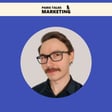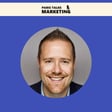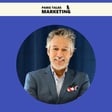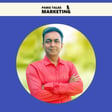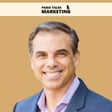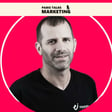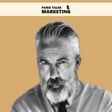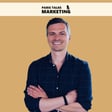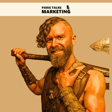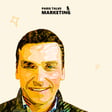Become a Creator today!Start creating today - Share your story with the world!
Start for free
00:00:00
00:00:01

LinkedIn Marketing Strategy for B2B and Personal Brands with Garrett Caudle
In this episode, Paris interviews Garrett Caudle, CEO of Influent, an executive social agency, to discuss the untapped potential of LinkedIn for B2B marketing. The episode discusses common misconceptions about LinkedIn, the importance of quality over quantity, and strategies for building a successful marketing presence. Paris and Garret also explore the evolving landscape of social media marketing, highlighting the shift from company-centric to people-centric approaches, the impact of founder-led marketing, and effective audience engagement tactics.
Tune in to gather practical advice on maximizing LinkedIn's potential for your personal or business brand.
Transcript
Introduction to Garrett Caudle and Influent
00:00:01
Speaker
Hi, everybody. Welcome back to another episode of Paris Talks Marketing. Today, my guest is Garrett Caudle. Garrett is the CEO of Influent, a social media company for LinkedIn executives. And I will let Garrett introduce himself. Welcome to the show, Garrett.
00:00:18
Speaker
Thanks, Paris. I appreciate you having me on the show. Big fan of the podcast. We're super excited to be able to come on and and speak to your audience. My name is Garrett. As you mentioned, I live here in Brooklyn, New York. I founded a company called Influence. We are a LinkedIn marketing agency.
LinkedIn's Potential in B2B Marketing
00:00:32
Speaker
So we work with you know founders and other thought leaders to help them you know do marketing, drive awareness, you know drive leads through you know personal branding and thought leadership strategies on LinkedIn.
00:00:44
Speaker
We are a couple of years old, founded in 2022, really started scaling after you know reaching product market fit. um We're now a quickly growing marketing agency. I would say a breakout agency in a lot of ways because we are growing extremely quickly yeah and excited to talk about some of the strategies that we you know that we deploy with with with our clients.
00:01:05
Speaker
It's awesome. ah LinkedIn is red hot right now, and and a lot of people would argue that LinkedIn is still the best B2B social network offering some still some degree of organic reach. um Would you agree with that? Do you think that there's still decent organic reach left in LinkedIn?
Quality Engagement vs. Follower Quantity
00:01:24
Speaker
i It's a great question and I totally understand the spirit of the question. The funny part is I wouldn't even use the word still left. I actually think that LinkedIn ah of all sort of social platforms that exist today is still the most under leveraged channel and has the most upside from any other channel.
00:01:42
Speaker
You know, the reality is is that ah we're still getting used to this idea that there even is social media in the world of, you know, the professional world or the world of B2B. And so because it's a little bit new to all of us, it feels sometimes like LinkedIn is reaching this saturation point. um It's just not true. When you look at, you know, the user base of LinkedIn, you're you almost up to a billion, if not maybe now more over than a billion.
00:02:06
Speaker
And only a small percentage of that user base is still you know active on the platform. As far as you know opportunity for you know more people to continue to invest in the platform and grow, there is so much upside. um So yeah, I believe it's basically the most under-tapped or underutilized untapped sort of opportunity in B2B marketing.
00:02:24
Speaker
Yeah. What but is maybe the top misconception that ah professionals that that want to manage LinkedIn, it could be either on the organic side, it could be paid ads. What is a popular misconception or a myth that you can help us to bust around LinkedIn?
00:02:42
Speaker
Yeah, ah the biggest myth I think is about um it's it's so this idea that that quantity ah somehow means success. um This is a myth in all of social media, ah whether you're on B2B or B2C, that somehow if you go viral or if you know you can get as many followers as possible, that that is going to equal the most results.
Target Audience Engagement on LinkedIn
00:03:05
Speaker
um for your business. And this myth is pernicious because it leads people to optimize their whole strategy for what's going to get them the most eyeballs when in reality, ah in social media in general, but especially in the B2B world, you don't need 10 million followers you don't even need a million followers if you are a business owner you need to think about your time total available market you need to think about who in your time is most you know i have the highest intent is most active on platform a platform like linkedin.
00:03:36
Speaker
And those are the people that you need to be actively engaged with you. Sometimes that's no more than, you know, 20, 30,000 people. That's a small group that you should be focused on appealing to them rather than trying to just become this sort of household
Shift from Company Pages to Personal Profiles
00:03:50
Speaker
name. That's the wrong thing to optimize for. Yeah. Do you help your clients to to actually to connect with their TAMs and build those first degree connections?
00:04:01
Speaker
Yeah, absolutely. You know, LinkedIn is very different from any other social media platform in that it is a connection-based or community model, right? So on TikTok, it's a discovery feed. You post something, TikTok's algorithm looks at that post and says, I think people who are this way or that way are going to enjoy that post, and it just starts pushing it out. LinkedIn is going to look at your connections, the people who are closest to you, your peers. It's going to show your content to those people first.
00:04:27
Speaker
And then the if you know whoever engages from there, it will show it to their connections. And so it's a much more sort of, you know you it's about community. It's about building your own little pond. And so for us to really help our executives get in front of that ICP, we have to send really targeted outreach and connections to people within their TAM who we want to be seeing their content.
00:04:51
Speaker
And that's not just as simple as like using Sales Navigator and creating a list, because as anyone knows who you know has done any sort of audience building on LinkedIn, um you know It's only as effective as ah you know people are willing to accept a connection request. And you know oftentimes, if you're sending cold you know connections, that's not good enough. So we have to look in other places. We look at people who are engaging with other thought leaders posts who are in your in your industry.
Evolution of LinkedIn Strategies
00:05:16
Speaker
We look at people who you know have recently changed jobs and maybe who are actively researching topics related to your industry. So it's not necessarily straightforward, but it's definitely has to be part of the strategy.
00:05:28
Speaker
all right and And in terms of the the overall approach, I think the old way of doing it was that people were investing in an active company profile. So posting regularly and trying trying to accumulate followers of the company page.
00:05:45
Speaker
And now i I feel like it's really shifting more ah to a person to person where the the individuals and particularly the C-level executives in a company, their personal profiles matter much, much more. um Do you see it that way? And do you help help clients also make that transition of the focal point from the company, the company page over to the executives? Yeah, absolutely. I mean, you know, I think about LinkedIn and the way that, you know, companies have approached LinkedIn in sort of eras, right? Like the first era was this sort of company page um approach where you know people would pay an intern ah or you know somebody on their marketing team or you know whoever
00:06:26
Speaker
to manage the LinkedIn company page. And the idea was, well, we'll just take our content from our blog or we it or wherever else and just kind of repurpose it and put it on LinkedIn. That's like a bulletin board almost. um And then you know people started experimenting with ads. you know What if we ran ads to the company page or on the company page and so on?
00:06:44
Speaker
um and i think that ah The reality is is very few people have generated real business results ah during this era through the company pages. And so, you know, LinkedIn became this sort of platform that was sort of third priority or just like not really something people cared a lot about. If I like i had ah a dime for every time I heard someone say oh LinkedIn ads, just they they just don't work. It's too expensive. Yeah. I mean, the reality is is that um LinkedIn ads aren't very effective for a lot of reasons. I won't even say they're not very effective at getting <unk>ica having high efficacy on your LinkedIn ads is not a straightforward thing to do. And that's for a lot of reasons. um But one of those reasons is because ah the content that most people are pushing toward ah just isn't good. And that's the reality of how people have you know treated LinkedIn as as this sort of bulletin board to sort of throw a bunch of content on. That was the first era of LinkedIn. And it's unfortunate that that era even had to happen.
00:07:36
Speaker
because it created this sort of this taste in people's mouth that LinkedIn is just this sort of soft platform that isn't really it's just sort of you have to have it but it's not going to drive any business. And what wasn't that kind of a copy paste from from Facebook when you would advertise the Facebook page, your Facebook page fashion, people just didn't really want to see content from pages, they wanted to see content from people.
00:07:59
Speaker
Yeah, I mean, the reality is, is like, what was social media for in the beginning, right? The very beginning of social media. It's for people to connect with people. And so businesses were like, well, we need to have some type of presence. We want to connect with people, right? But how much connecting with people were businesses ever doing on social media, on any platform? ah You know, very, very little. um So really, this era is not just a LinkedIn era. It's like a, you know, whole era on in the world of social media businesses picked it up and said we can use this and then you know didn't have much success with it. um I think what we saw then happening in B2C is that businesses quickly realize well the best way to connect with consumers isn't that our brand is going to be posting on our branded TikTok page or branded Facebook page. It's that we're going to find people who can reach other people using these social media platforms and that's how influencing happens.
00:08:46
Speaker
Well, that same thing, that same phenomenon that happened in B2C is happening in B2B, but it's just happening like 10 years later. And the difference is that with B2B, there's still this massive opportunity and you don't necessarily have to look and you can look outside your company for these influencers to connect with other people.
CEOs and Social Media Engagement
00:09:04
Speaker
But in this new era, you can look inside your company and you can say, are there people inside of our company who can represent us and connect with other people in an authentic way on these social media platforms?
00:09:15
Speaker
And oftentimes the founder, because they have, or co-founders, whoever, because they have the expertise, they're a thought leader, they have the stories, they have all of that, they can represent the brand and connect with people. So that's the second era that we're talking about is actually taking, you know, LinkedIn and approaching it from a sort of thought leadership first, a a people first type of approach. Yeah.
00:09:37
Speaker
And is it hard now that the right people could be the the people that are the most active, but I think also to have credibility, it needs needs to be somewhat senior ranking, if not straight to the CEO or C-level people. um Do you sometimes struggle with getting those people who are not historically or natively as social media savvy as some of the younger colleagues?
00:10:02
Speaker
Just kidding, just getting them pulling them from behind the curtain and trying to get them to become active. Yeah, you know, Paris, this is something that like, um you know, we have, we struggle with this, not struggle with this, this is something that an obstacle we always have to face, which is that we, you know, we work with founders who they know that they need to be the figurehead because, you know,
00:10:23
Speaker
They're just the right person for it. They have this rich history. Maybe they have a lot of expertise, but they're sort of reluctant to step into that role. And you know this is something that, in my opinion, is just and adapt or an evolution of what it means to almost be a founder or a CEO in sort of the you know modern era.
00:10:42
Speaker
um This isn't something, in my opinion, that you know founders will be able to opt out of for much longer. ah If you want to be at you know the head of a company, that means sometimes you're going to have to meet with investors. It means sometimes you're going to have to go speak at a conference. ah And that's the nature of what a CEO, well, not the nature, right but it's certainly an aspect of what it means to lead a company. um And the digital space is just one of those many venues where that needs to happen. Now, does every founder need to be this you know
00:11:13
Speaker
does every company need to be this personality-driven sort of ah you know personality cult of the founder? No, absolutely not. But does every founder need to play a role in their company's you know marketing by being that sort of digital ah so representation? Yeah, I think so. um But there's other ways you can activate people throughout your company.
00:11:31
Speaker
you know It could be all about you, but it could also, you know you could bring in people from your organization and you know be the sort of the person who ah you know you're guiding people through your industry by talking with other experts at your company. There's other ways you can do this. Yeah. I actually had recently interviewed Adam Robinson from retention dot.com. Yeah. Love Adam. He's built a following of now, I think 80,000 plus people. and He shared with me on on our during our discussion that he's spending the large majority of his time, probably 75% of his work week, is just dedicated to his LinkedIn activity. Most of that is is his posts, but it's also ah commenting and engaging in other people's posts. And he said that while he can't directly quantify the ROI, and he never will really be able to,
00:12:21
Speaker
He's totally convinced that this is what is driving most of the growth and the value ah for him right now. And it was fascinating conversation. um But then I look at someone like him and I think, gosh, I mean, how could I ever get there? um Could I afford to neglect all of my other duties as a CEO and start spending 75 or 80% of my time per week on LinkedIn? What would that mean for for my role as a CEO?
00:12:51
Speaker
Do you ever even ask your CEO clients to to make some similar types of commitment or what is the real commitment yeah that you're asking them to make? It's a great question. um You know, first of all, I love Adam's create. I think what he's doing for evangelizing about, you know, ah the use of founder led marketing, I think is awesome. I think he's a great, you know, case study and and why it can work. And I listened to his episode with with you, Paris, and I think, you you know, there's some great tips in there about how he approaches things. His build in public sort of strategy um isn't for everyone. And I would even say that, like, there's some big downsides to doing it that way, and that there are other paths. So if you're a
00:13:31
Speaker
listening to that episode and thinking, oh, i I don't want to do it that way. That's OK. It doesn't have to be done that way, just so everyone knows. But it is you know he's ah he's ah he's a great guy who's gotten a lot of success that way. um you know To me, the commitment is actually a lot less about the person. It's more about the organization. Is the organization going to commit to LinkedIn as a channel?
00:13:51
Speaker
ah And that's really where you know we have to have conversations with our clients. Do you believe in LinkedIn? If so, um how much? Are you you know ready to sort of you know really invest in this channel? Because this is about building an engine over time. right There's going to be ah ROI, but that ah ROI is going to be you know compounding. It's a flywheel. So we need to invest in this channel for you know a good amount of time to get this to become what it really can be for your business.
00:14:18
Speaker
But that's about organizational commitment. When it comes to the actual individuals, the CEOs, the reality is is that you know the reason that Adam spends so much time isn't because he thinks more than any other you know executive that LinkedIn or you know personal branding is is the future of marketing. I believe that too, but I you know don't have to spend as much time. The reason why is because when you're building out that strategy,
00:14:40
Speaker
you can basically ah do the same thing you do with any other strategy marketing strategy, which is hire great people or agencies to augment the time you
Delegating LinkedIn Strategy Tasks
00:14:51
Speaker
spend on that. right like When you think about you know Adam and what he's contributing to that strategy, right now I know he mentioned he's doing a lot of his writing. I know he's involved in a lot of his ideating. I know he's involved in you know ah he's obviously on video a lot, so he's there you know personally.
00:15:05
Speaker
um There are a lot of clients that we work with who have just as much success as Adam, ah but who are involved only at maybe like you know three or four hours per week. um And that's because you know they don't need to be the the writer. They don't need to be the video editor. They don't need to be ah you know the ideator. These are all marketing capabilities. um Being a great writer for LinkedIn, if if we limited all founders to those who are really great at writing, and those are the only ones who could have success on LinkedIn, you'd be missing out on a ton of amazing thought leaders.
Influent's Content Generation Process
00:15:43
Speaker
Because the reality is is that there's nothing inauthentic about showing up to an interview, let's say, once a month with somebody who's going to interview you based on certain core topics that they decided with you that are important for your LinkedIn, and then writing the content for you in a way that matches your voice. That's absolutely something that someone can do for you that you don't have to be involved in.
00:16:02
Speaker
So that that is the core of your service, Dan, I suppose, that influenced. That's exactly right. And you driven content generation. that's That's exactly right. We basically say in this whole process, what are the things the founder or the thought leader has to be involved in? And what are the other things that we could actually level up? Because ah the reality is, is that and not every founder is going to be the best writer, the best video editor, the best LinkedIn strategist, even the best marketer. That's not every founder. But what is that founder? Well, that founder is, you know, the thought leader. So they're going to know a lot about their industry. They're the storyteller, they're going to have a lot of stories to tell. And they understand their ideal audience really well.
00:16:39
Speaker
That those things let's optimize for the rest we do. So our whole process is, you know, it's journalistic in nature. ah We're doing monthly interviews with our executives where we're going through and asking them questions about their company, about their industry, about, you know, topics that we ahead of time will have strategized around.
00:16:57
Speaker
and bring data to the table and you know interview them and others at their organization. And then basically take all of that together into you know ah a single sort of ecosystem where we can then pull out posts and points of view that that executive or others at their organization shared. And then we synthesize that into really great punchy content for LinkedIn.
00:17:19
Speaker
Great. So then I assume then you must have access to those CEOs profiles in order to manage their posts on their behalf. Yeah. So ah the approach we take can differ by client. um you You know, some CEOs really want to retain access. ah Some don't. I'll just say this, we find as many opportunities as possible to save of our executives time. um So oftentimes, you know, that that can involve various levels of interaction with their actual account.
00:17:48
Speaker
What if they don't give you access? then that means They're going to have to manage the posts themselves. Does that present a roadblock to to your effectiveness? Yeah. you know um The vast majority of the work isn't in the publication of the posts. It's in the preparation of the post, ah you know the development, um from the ideation all the way through the actual you know sourcing of the content, through the crafting of the post itself.
00:18:13
Speaker
Um, so, uh, you know, if we can create a system that, you know, does all those things to the best, uh, to the, to the best degree we can at that point, uh, you know, whatever's left in terms of publication and that kind of thing, um, gets worked out. Um, most of our clients aren't that way the way you're describing. Uh, most of our clients are pretty open with our, with our ability to handle their account.
00:18:36
Speaker
Yeah. What are you seeing in terms of post content and formats?
Effective LinkedIn Post Formats
00:18:41
Speaker
I love asking this question and a lot of people have different views on it. and There was a time when video was was definitely the way to go and the video content, ah video posts were getting the most engagement. But now I think it has shifted. I see a lot of posts that are just text only that do really well. I see a lot of these these documents maybe you know where you're you're swiping swiping through the PDF. Yeah.
00:19:05
Speaker
um Or maybe there's not even a clear-cut answer. Maybe it would just depend on who's your audience. But what can you tell me and our audience about formats and different types of posts that are that are working today?
00:19:19
Speaker
Yeah, so, you know, LinkedIn, like any other social platform, has an algorithm that is a bit of a black box, right? It's constantly changing, difficult to see within. um By working across a ton of executive profiles, we're able to kind of see how things shift over time. um In the past, it used to be a little bit more ah sort of um ah equal across formats, videos, graphics, written posts. so It was more much more about optimizing for whatever is the best medium to contribute or to communicate your point of view. um Sometimes if something's very complicated, it's helpful to have a graphic, we would use a graphic. Sometimes if something you know ah involves, if we got a really good clip of the founder talking, we'd use a video, so on.
00:20:01
Speaker
What we've seen over the last like year is that LinkedIn is really shifting in the way they treat video versus written posts. LinkedIn has always been a very, I guess, writing first platform, meaning that like most people in the way they interact with LinkedIn are sort of scrolling throughout their day and not necessarily going to take the time to sit and watch or listen to a video. um And so writing written posts have always done very well. We've seen over the last year that written posts do even better um and other posts like you know video posts in particular have started getting worse and worse impression share.
Video Content Performance on LinkedIn
00:20:38
Speaker
Now, um what we have noticed is over the last three or four months, LinkedIn has built this new feed, ah this discovery type video feed that's not dissimilar to like a YouTube shorts. It's videos, 60 seconds or less, that are basically pulled into that feed. You don't have to post directly in that feed. They actually, you post a video, post less than 60 seconds, LinkedIn automatically pulls it into their feed.
00:21:01
Speaker
And it's becoming sort of this separate algorithm that's much more discovery-based. So if you're posting about SEO strategies and you know there's somebody who works in SEO, they can scroll there and see your post. And we've had a few clients who have posts that ah video posts that have gotten picked up by that feed who you know the post was at 3,000 impressions before and is at 30,000 or even 60,000, 100,000 impressions after.
00:21:24
Speaker
So what happens with video content is we're right now sort of in the transition phase phase as this new feed rolls out. But what I will you know tell your listeners is this. um Focus on what's going to drive the most value. And the quality is more important than anything. So you know don't post a video just to post a video. um Focus on writing really great posts. And if the video contributes, then great. And if it doesn't, please leave it off.
00:21:53
Speaker
And then last thing here, Paris, because I know the ah video, you know, a video gets a higher quality engagement when you think about it, right?
Being Well-known vs. Being Known Well
00:22:00
Speaker
So, you know, when someone looks at your face talking for a bit and sees you, and they see your face on their phone or their desktop over and over each day, there is a a different quality ah to that engagement. um They're getting to know you. they' getting to know Yeah, and so there's utility there. So I wouldn't say just abandon it because it gets less impressions work it in there But don't maybe you know, don't but let it become your entire strategy is what I'd say Yeah, I I'll never forget one of the things that Adam said which is there's there's a difference between being well known and then being known well well and that well known is just pure popularity like maybe being an influencer and But being known well means that you're people really know you as a person much better. And and when he would go to conferences in person,
00:22:54
Speaker
People would come up to him and speak to him as though they they they really knew him well and and almost like they were friends. and There was a degree of intimacy almost right out of the gate. and Of course, he's looking at a total stranger, but they feel like this is somebody that I i know very well. and I think that's that's one of the keys to unlocking this, at least for him.
00:23:16
Speaker
Part of that, though, is I think his his approach of being radically transparent with with what he's sharing and um with financial data and the and the successes and failures, especially the failures.
00:23:31
Speaker
but you know and as As you're talking through that, Paris, just to jump in really quick. um So ah my longtime partner, she is a an influencer in the B2C
B2C vs. B2B Community Building
00:23:42
Speaker
world. And it's you know it's really funny because I have you know access to that world through her and i see sort of I get to talk to and become friends with a lot of influencers.
00:23:52
Speaker
And there's so much that that world can teach us about the B2B world. And you know so many of these sort of experiences that some of these founders are having, like Adam, are experiences that you know influencers in the early days on the B2C side were experiencing, were having. like Building a community and then all of a sudden realizing like you know you run into somebody,
00:24:14
Speaker
And you're like, oh, these aren't just 100,000 whoever's. These are real people who are getting to know me personally. And it is a very interesting phenomenon that's happening. And there's so many you know similarities there. Something I will say is that you know building a community is all about providing value, right? And authenticity is always going to be part of that value because it creates human connection. But there can be sort of a difference between an influencer, both on the B2B and B2C side, who provides value through mostly education.
00:24:43
Speaker
and somebody who provides value through mostly entertainment, right? And so with Adam, right, there's a little bit of a mixture there, right? Like people get to know him, they learn about his struggles, they feel something. He definitely is funny, too. I mean, yeah, it's reverently funny. Yeah, it's totally. And there's an entertainment value of there. It impacts like six cents and some of the big 100%. 100%. And there is a true entertainment value there. And that's going to create a little bit different of a type of connection than a founder who maybe really focuses on just the you know the education part.
Quantifying ROI on LinkedIn Marketing
00:25:18
Speaker
um So just I would just encourage any founder, if they see the Adam thing, don't be discouraged. You don't have to be that kind of ah you know if creator. You can be much more focused on you know the education part.
00:25:32
Speaker
So let's let's get to, I think, one of the elephant in the room type type of questions, which is CEOs are often always looking at quantifiable ah ROI for for any investment. and And some of them are former CFOs, which make them even worse.
00:25:47
Speaker
So what do what would you say to a CEO that says, all right, look, this all sounds great. I know I should be, I should be doing this. I know I have to be doing this, but ultimately when we're six months or 12 months down the road, how are you going to show me the ah ROI in terms of how is this impacting my bottom line or my revenue?
00:26:06
Speaker
Yeah, so this is a real challenge ah for obvious reasons because anytime you're investing in a a strategy where attribution is really difficult, it creates this sort of conundrum, right? Where like you sort of have little signals here and there that it's working, but oftentimes attribution, modern attribution isn't you know good enough to be able to tell the whole story, which leaves you sort of sitting there wondering, am I getting ROI or am I not? And typically when people have to ask themselves that question, they'll just err on the side of I'm probably not and therefore it's not worth doing.
00:26:36
Speaker
So, you know, there's an attribution problem piece to this. um You know, there's also a sort of a, ah you know, we're we're used to the world of performance marketing, where you put a dollar in and you get, you know, four back and you immediately say, all right, well, I know my CAC to LTV. I know my, you know, we have all these defined numbers and we say, all right, let's go. And we can kind of measure our ah ROI from day one. um And some channels aren't like
Solving Attribution Challenges
00:26:59
Speaker
that. They aren't like that. And that's something we have to understand and accept is that you know When you're working in social media, you're building an engine. It's a flywheel. You're having to invest in something sort of pre-ROI with some trust that you're building it the right way, and it's going to be know drive ah ROI at some point. um and so Those two know things are at play. and so Usually, but you know there's two ways that we're kind of approaching this. The first is trying to help solve the attribution problem. um so you know The more you can measure this, the easier it's going to be to tell the story of its impact, and therefore, the easier it is going to be to be able to prove out ah ROI sooner.
00:27:30
Speaker
um So you know what we're doing is you know we've developed some actually software that helps us basically track engagement ah down to a you know person level, not dissimilar to the stuff that you know Adam is doing in RB2B. And then combining that with person level identity tracking such as RB2B.
00:27:48
Speaker
and then being able to sort of look intelligently across sort of any company's ecosystem from their site to you know any other digital property they have to their LinkedIn engagement and the connections we drive and so on. And be able to map all that out in a way that helps us be able to really track who is coming from LinkedIn, who's not, who you know how did LinkedIn play a role in someone's journey, how didn't it,
00:28:10
Speaker
We have a lot of clients where we'll do an audit of their business. They'll tell us we don't think LinkedIn's working. We'll go in, we'll do an audit as part of our understanding if we're going to want to be partners with them. We actually show them, hey, look, 30% of your pipeline has actually engaged with one of your employees or your founder's posts over the last year or nine months or so.
00:28:29
Speaker
um And that helps them understand, oh, they they came in through PPC or paid search, but really, they're part of this ecosystem. So anyway, the attribution thing is something we're working hard on. We have some really great solutions. That helps us tell a better story. And then when when it comes to like the actual organizational investment and you know when to expect ROI, what we try to do is we try to tell people that like if you're doing it right, in the first 90 days, you should see green shoots, meaning like little things popping out of the ground.
00:28:56
Speaker
that's going to look like your existing network reaching out. People who used to be clients kind of coming back, you know people talking to you, qualitative you know qualitative stuff. you know You're at a conference and someone it says, hey, man, I really like this stuff you're posting. Or, hey, you know this is really neat. um By six months, you should be seeing some regular lead flow. um In most businesses, if you're not seeing some standard lead flow by six months, I don't think that you're leveraging the channel fully. um By a year, we have a 90% client retention rate.
00:29:23
Speaker
ah So essentially people who make it a year with us, just, you know, 90% of them will continue on to another year. um That's because when you build that engine for a year and you do it the right way, it becomes a huge part of your marketing. And ah ROI as like a reason to leave doesn't become an issue because our clients can see it.
LinkedIn's Role in Lead Generation
00:29:39
Speaker
Yeah. The middle phase that you mentioned, which is some lead generation, are you talking about leads that would come through all inbound channels, including website or specifically DMs in LinkedIn?
00:29:52
Speaker
I'm talking about people who come in from all lead sources, even paid. We did an analysis one time of someone's paid traffic, um especially on like you know keywords that were like brand like paid paid branded search on Google PPC. And there was i think I don't remember what the exact number was, but I think it was like a third also had some type of engagement on LinkedIn, whether that was like ah they were connected to the founder or they had liked a founder's post or whatever.
00:30:18
Speaker
um That's like, in in this you know client's instance, that was like a sizable number of people who otherwise would have been categorized as a PPC lead, but were truly influenced by the LinkedIn channel. um So yeah, that's what I mean is that it's the B2B buyer journey the b two b by her journey is very ah not very often linear. It's about touch points. And the where somebody converts is almost, not almost always, but can often be different from where somebody's nurtured.
00:30:46
Speaker
Yeah, absolutely. Have you ever done the so-called self-reported attribution where in the in the lead gen form, you just ask, where did you first hear about us? And linked in broadly, I could be just putting linked in as one of the answers allows you to at least get what's likely a first touch attribution.
00:31:07
Speaker
Absolutely. Yeah. So this is like a 101 thing that we do with our clients is we ask them or very, very strongly recommend to them that they add this self-reported attribution onto their forms or that's in the sales cycle that this you know at least the salesperson is asking that and logging it in the CRM. um That's sort of the 101.
00:31:27
Speaker
you want to graduate to another level, ah you know, use certain ah person level sort of website tracking such as RB2B or, you know, mySquid.io is another great option. These platforms can really help you understand how web traffic is, you know, coming from places like LinkedIn. um We're doing, you know, we're looking at people's web traffic and then saying, you know, matching that person to LinkedIn activity, the data that we're scraping from LinkedIn.
00:31:51
Speaker
um So anyway, point is is that, ah yeah, there's there's sorts of levels to this when it comes to attribution, but self-reported is certainly sort of the basic level. Yeah. Yeah.
Brand Building vs. Quantifiable ROI
00:32:03
Speaker
I also think we we help some of our clients to do podcasting. I think there's that there's a little little bit of maybe an ego element here at Play as well, which is that When you are building your personal brand, there there is real personal satisfaction of building building a brand of your your name and your persona.
00:32:26
Speaker
and Well, ironically, our podcasting service is also extremely sticky. And it's probably the service where we can least prove quantifiable ROI compared to our Google Ads management and SEO. It's it's probably the hardest to to to build the case for attribution and or ROI. But it's extremely sticky. And I think one of the reasons is that just simply the The psychology of this is that building your personal brand is something that is is personally rewarding. And if somebody is helping you do that, you're you're not you're you're not going to scrutinize the bottom line quite as much. Yeah. Yeah. You know, it's interesting. There's this interesting dynamic inside our business where that's what you're saying is exactly true, that ah you know we're working with founders. And when you start posting for founder and they start building up their audience there, they get that dopamine hit that everyone gets from social. media. And it becomes, you know, very satisfying. and And that's great. And it does make our service really sticky, especially in the beginning. And that's really helpful, right? Because we need people to buy in like this is again, like if we can get them to a year, they're there with us forever, because we need them to buy in long enough for us to be able to build this engine. So that has a lot of utility for us. And that's great.
00:33:43
Speaker
However, the other part of this dynamic is that we really need that founder at some point to be able to step outside of that, because the reality is is that it can become a really big distraction when you're trying to understand what it is about a person that makes them unique or different or you know appealing to an audience. And when we evaluate ourselves and we try to say, oh, I'm really interesting, and here's why. Here's why people find me interesting.
00:34:09
Speaker
I guarantee you that you know if you ask somebody that, what they tell you is going to be different from maybe what you would say about them. right The reason why is because we sort of don't really see ourselves in the way that other people see us. and You need a third party. You need to be actually pretty scientific about how you collect that information and then action it with your personal brand. and If you're sitting there in this ego exercise, you're not going to be led by you know, what the data is telling you, you're going to be led by your own sort of, you know, I want people to see me this way. And therefore, that's what they see. And therefore, that's what we should optimize for. And that's just not the right way to do it. So yes, it's a useful thing for us in the beginning. But over time, we try to help our clients step outside of that and focus more on the
Ego and Data in Personal Branding
00:34:49
Speaker
data. This is a marketing, this is an art and a science. And the science part needs to become more part of it as we sort of you know build sophistication. That's ah it's a really good point. But I suppose the
00:35:01
Speaker
there you You're not complaining that this is what helps to make your service really sticky because that's that's a good thing. No, yeah. I think the only way to be ah build a marketing agency is to help your clients build their businesses. right Very few marketing agencies can exist and grow if they're not actually helping their clients build their businesses. and so For me, having you know a sticky service where you know people um you know really they feel that dopamine hit, I think it's great, but only insofar as it allows us to um build a better, longer relationship with them so that we can get to the results that are possible. Because the reality is, is that if you look, ask our long-term clients, it's not the ego part that's keeping them with us, it's the results part. um And if the ego helps us get to the results, then that's fine with me.
00:35:45
Speaker
Sure. Yeah. I mean, yeah, maybe the ego gets you through the first six months and then the real results kick in and then count Yeah, yeah, exactly. I mean, you know, and i and I think I said this before, but it's probably worth underlining again. um This is very much one of those marketing strategies where the more you put in, the more you get out, which sounds obvious. But for a lot of people, more doesn't just mean ah you know how much energy you put into it. It's also about time. How much time, both I mean, like months, are you going to dedicate
Engaging Through Comments
00:36:15
Speaker
to this? The real winners, like Adam, are the ones who said didn't just say, I'm going to try this out for a month. I'm going to try it out for three months and then decide if I want to do it or not. They're the ones who said, no, I believe in this channel and I'm going to give it i'm going to do this for at least a year. um When you have that level of commitment, what you're going to get out is a really, really high level strategy that's going to become a huge part of your marketing.
00:36:37
Speaker
Yeah. One aspect that we haven't chatted about is the activity around engaging with other people's posts. Is that also something that you you encourage the clients and C-levels thought leaders to do as well, or or that you handle for them? And how important of a role is that?
00:36:58
Speaker
Yeah, so this one is a little bit more like a done with you type service, most of our service at least today. Today, as I'm speaking, our most of our service is done for you. But the common side of things is a little bit done with you. And what I mean by that is, you know, we help surface.
00:37:13
Speaker
um the right posts, the right people that should be engaged with. There's a big science to this actually, being able to look across different industry experts and sort of identify who has you know the the types of people following them that we want to be in front of. And once you identify those people, we are able to then bring those people to the table and look at the posts that they post and identify for our clients. These are the ones you really need to be focused on. When it comes to actually leaving the comments,
00:37:40
Speaker
This is something where oftentimes it's better for us just to create a process where the executive can one time a week for 20 minutes go in and leave the comments they need to leave than it is for us to necessarily manage it for them. um This is not always the case, but you know I think especially with comments, there's a standard for authenticity that you know AI comments have really risen that bar. right AI comments are trash, and I would say if never, ever, ever do them under any circumstance ah because they will actively hurt your personal brand.
Creating a LinkedIn Lead Scoring System
00:38:10
Speaker
And so you know if a team doesn't perfectly approximate your voice or your point of view in a comment, it can really damage, um I think, your reputation. So I think it's important that you know right now, at least in our service, that we have our clients be a little bit involved in that part of the process.
00:38:25
Speaker
Yeah, I absolutely agree. I've found that even some of my thoughtful comments have done better in LinkedIn then than post. and post themselvesves yeah um Comments are becoming more and more a bigger part of what it means to build a following on LinkedIn. They always have been, but um as sort of LinkedIn grows and more people are posting, ah but there's a part of the strategy which is like, are you contributing to the conversation? But then are you also sort of showing that you are a an active you're you're an active and willing participant in other people's sort of dialogues? And so you have to be willing to like step into those conversations and not just be sort of a one-sided, you know, I speak into the void, but I don't actually you know participate.
00:39:08
Speaker
um But yeah, it's becoming a you know a bigger and bigger partner strategy for sure. Yeah. I want to bounce an idea off of you. And we we've been working on some very rudimentary lead scoring system and methodology that's connected with both cold email outreach and LinkedIn. And LinkedIn metrics, there are really three categories or of KPIs. One is the impressions of post impressions and overall impressions of posts. The second is the engagement of those posts. So it could be um a like or a comment, but the comments get a little bit more weighting than and then the likes. And then the third bucket is people that have visited my profile, which I consider to be almost as good or in some cases even better than a visit to our website.
00:40:00
Speaker
And we're trying to assign, I guess, we're trying to create a lead scoring methodology there. Do you think that those are the right KPIs? If aren't if our goal is to try to to to generally measure the effectiveness effectiveness of the the linkedin the LinkedIn activity from my profile, or do you think we're missing anything? Any other KPIs there?
Measuring Engagement on LinkedIn
00:40:24
Speaker
Uh, what a great question. And I love that you are actively working on building this type of reporting out because to me, this is, you know, when I talked about attribution before companies that put in the effort to do what you're describing are going to have such a better picture of the, you know, uh, the efficacy of their efforts. Um, and it's stuff that we're actually, we've built into, uh, into our service so that companies don't have to go through the pain of setting all this up and setting up the lead scoring and so on.
00:40:53
Speaker
But to answer your question, I think you're ah you're hitting them right, the most of the main sort of things you can measure, right? Like views are really difficult because you don't have a solid sense of who's viewing your posts and things like I tell you here are all the 10,000 people who viewed your posts. So you're measuring what is maybe easiest to be measured, likes, comments, shares, profile views. I would add in there, right? Like if someone accepted a connection request, I think you, I don't know if you said that, but that would be one that you could measure.
00:41:18
Speaker
No, I didn't, but that's that's a really good one. Yeah, yeah I think like if someone accepted a connection request, I think where you would maybe want to go with this, um you know if you had like a LinkedIn newsletter, you could measure that. If you had you know LinkedIn Live and someone registered for LinkedIn Live, you could measure that. So the more engaged you are in the platform, you can measure those things as well. But where it would actually go with this isn't necessarily deeper into the platform. there aren't you're At some point, you're going to run out of things to measure because they're simply, you can like I said, you can't measure a view. But what you can do is start to um be more sophisticated in how you measure it. So rather than just saying, ah Billy liked one of our posts, let's say Billy liked our posts over three months. And here are the different topics of each post that he liked.
00:42:03
Speaker
And here are the different formats of those posts that he liked. And now when I reach out to Billy, I know that he actually was really interested in ah this specific revenue topic. um And by the way, I also know that three other people at Billy's organization, who he reports to, have also been engaging with other people at my organization. And you start to build out a little bit more of a sophisticated ah sort of map of how you know Billy and Billy's company have been interacting with your entire ecosystem.
Influent's Proprietary Software
00:42:31
Speaker
and then layer that in with other stuff. If Billy and his team have also downloaded white papers and attended a live event, you talk to them at a conference and mix that in with CRM data and website data. Maybe he visited your website. You see that through MySquid or through RB2B. All of these things can be kind of put together. um But yeah, to I guess to answer your question, you're measuring the right things. It's just about how sophisticated is that measurement and are you able to sort of aggregate it and sort of do other things, interesting things with Yeah. And I was really wondering out loud at that at that time, shouldn't there be software that can that can do this that can just say, look, I want to be able to, if somebody that visits my profile, I want to give them 10 points, or somebody that engages with a post, I want to give them another 10 points. An impression, I mean, it's harder to track all the the people on those impressions, but um accepting a connection request, five points, or whatever.
00:43:25
Speaker
um But are you saying that you've already built the software or does this software exist? The software exists. It exists inside of our agency as a proprietary tech that we use to help our clients. um We're not a SaaS company, nor do we ever want to be really a SaaS company. What we want to do is we want to create incredible technology that's the most valuable to people who work with us, right? Like this technology um could be, you know, you could kind of dumb it down and like really make it like super simple to use and like maybe make it widely applicable. What we want to do is build as much sort of detail and sophistication into it as possible.
00:44:04
Speaker
which makes it something that we can provide as part of our service ah that is most valuable to people who use us. um So it becomes a little bit of a moat for our service. But yes, to answer your question, we've built this and we use it for our clients and it allows us to optimize for the right things. It allows us to do attribution better. um Yeah, it's a
Founders as Marketing Leaders
00:44:26
Speaker
pretty neat system.
00:44:26
Speaker
And if I understand correctly, you do not have plans to roll this out into a separate SaaS product? We do not. Is it tempting at least? It's such a funny question. Maybe it's a temptation at first, or at least it was something I considered.
00:44:45
Speaker
ah The reality is is that I think that I think the utility of a tool like this is only as high as people are able, this tool is only as useful as people who are able to build, who able to do the strategy that we do for our service well. And I still think the gap there is huge.
00:45:07
Speaker
I think when you look at people who can who can actually do founder led marketing on LinkedIn well, it is like a 0.0001% of the current market right now. um Putting this tool out for that 0.001% and asking the them to pay 500 bucks a month, I don't want to do that.
00:45:24
Speaker
I want to help more people be able to do this strategy. And if this tech can help them do it better and faster, that's what I want. um So I think for us, we feel really confident and comfortable saying we want to keep ourselves focused on helping more founders build this founder-led marketing strategy.
Clientele of Influent
00:45:40
Speaker
um Yeah, so that's that's sort of the fair enough. Fair enough, Garrett. So who is hiring you? Is it the founders? Or is it someone in marketing that's saying, Hey, I need you to get our founders off his ass, or pull them from behind the curtain? um who Who is it that you usually comes to you? Yeah, it's both. However, there is a loose sort of um correlation between the smaller startups, it's obviously mostly the founder,
00:46:12
Speaker
larger companies that are in, you know, ah the 200 to 500 person sort of, um you know, headcount sort of size. At that point, we do see a combination of, ah you know, a go to market later, ah you know, VP of of marketing, CMO, um who basically some you usually this, we see this archetype a lot, a scrappy VP of marketing, who has come into an organization, it's a little bit older,
00:46:39
Speaker
with a founder who maybe is sort of a little bit behind and has come in and said, you know what, I want to make a difference in my organization. I know we can do this really well. I want to change things up. Maybe they are going with this like old SDR sort of sales model and they're like, wait, I want to do founder-led marketing at scale. I want to utilize you know like really innovative, cold outbound strategies. like Somebody like that archetype is great to reach out to us and say, like hey, I want you to help come in and like really transition our organization into a more founder-led marketing, sort of people-first, you know contemporary B2B marketing approach.
00:47:12
Speaker
um Those conversations are fun because typically with those larger enterprise sort of businesses, it's not just about the founder, it's about how can we find thought leaders throughout the organization and make this sort of like a bench of people that we bring to market.
Amplifying Messages via Employee Advocacy
00:47:25
Speaker
asification Yeah, I think that there's a ah huge missed opportunity around amplify amplification amplification through, I guess, employee advocacy, for lack of a better word. If you could just get a committed group of people in the company two to engage with with every post and comment and to reshare. The amplification benefits are are so massive, especially if some of those folks have large followings in their own right, and they probably would. But I think a lot of companies are missing that, just to just to create a st structured program around employee advocacy and and amplification.
00:48:04
Speaker
I completely agree. I think the words that I like to use, I don't like to use amplification because what it seems to me is like basically um you know asking a bunch of employees to sort of push the founder's POV. I actually don't think that's the right way to go about it. I think the right way to go about it is to um find sort of micro influencers throughout the organization who are specialists in any particular subject. So, you know, the way that influencing works, right, is that you have sort of broad people, ah people who talk about broad topics, provide broad value, have a broad more broad audience.
00:48:34
Speaker
And then you start to niche down. And every time you niche down into a sub-niche, you're creating a micro audience. And those micro audiences are super powerful. So if you're you know an organization who focuses on, ah so OK, us, for example, copywriting is one part of our agency. But we have a lot that we do. But copywriting is one part. um A kick-ass copywriter at our agency would be a fantastic micro influencer to talk about how copywriting has changed and what good copywriting looks like.
00:49:00
Speaker
That's a great little niche that they should be owned. And can you support that person in owning that niche? There's all sorts of ways you can support them. But in my opinion, that's how I would do it, rather rather than just having that person just re-share the CEO's posts. Yeah. it's It's a very fair point because then they they might just appear as a just kind of a mouthpiece for the CEO and not not authentic.
00:49:22
Speaker
Yeah. I mean, it's like, you know, it's like people within a community who are like part of the, who are like, you know, if there's a community and like, it's, it's like the different admins of the community, like all trying to like, raw, raw
Beyond LinkedIn: Enhancing Other Efforts
00:49:33
Speaker
about the community. It's like, it's way more powerful to have people build their own little communities and all ladder up to this larger thing than it is to just have like little cheerleaders throughout your organization. Yeah. But yeah, really, really good point. Yeah.
00:49:49
Speaker
Um, great stuff. Paris, I was going to say I've like one more little like, uh, topic that I'm excited to talk about it. That's all right. Absolutely. Let's do it. Yeah. So just really quickly, um, the utility of a founder led marketing strategy.
00:50:04
Speaker
I've talked about a lot today in the context of ah LinkedIn, and you know that's because we're a LinkedIn marketing agency. The reality is is that you know for the clients that we build this engine for, ah the utility goes well beyond LinkedIn and even beyond social. And so what we're seeing with some of our clients is not only are they doubling down, they're having other thought leaders of the organization become part of the strategy, but they're also utilizing their founder and other aspects of their marketing.
00:50:30
Speaker
And what I mean by this is like in cold outbound campaigns, like like scaled one-to-one personalized outreach campaigns using platforms like Clay, when you have a founder-led brand that you've already built on a platform like LinkedIn or Twitter, and then you use that in your outbound campaigns, we've seen crazy numbers that you otherwise wouldn't see from another another person.
00:50:54
Speaker
Same thing with like affiliate programs when you're working with other influencers. There are so many interesting opportunities that are unlocked when you invest in this. And so what I would you know encourage people as they're thinking about ROI for this type of strategy, um open your mind a little bit to what this also unlocks for you as a company and how it might impact the efficacy of your strategies across the board. ah Because truly, ah this is about changing your entire approach to marketing. It's not just about a channel over here on the on the side, if that makes sense.
Future of B2B Marketing and Conclusion
00:51:24
Speaker
Yeah, it does. Now you've got you've got the wheels turning. So you're creating a lot of assets that could be used for hyper personalized, cold email outreach for for the SDRs by not just assets, but the personal brand is an asset. Meaning like you get an email from a founder, imagine you got an email from Adam,
00:51:46
Speaker
at RB2B, Adam has, what, 80,000 followers on LinkedIn. like You go and look at Adam's LinkedIn profile. If you hadn't seen him before, you're like, oh, shit. like This dude has some smart stuff to say. it's it's you know It just it create creates this sort of like ah this compounding effect of you know every other every platform you can work that founder into at that point or that thought leader into becomes you know better and better better results for each one.
00:52:13
Speaker
That's really interesting. And then, of course, with a plug with a platform like a clay that allows you to try to match up these bits of content and to personalize them, that that ah enables the the personalization at scale. Oh, yeah. I mean, these two strategies can like work really well hand-in hand in hand.
00:52:33
Speaker
um it's ah Yeah, there's a whole playbook for what the future of B2B marketing is, and we don't have enough time to talk about it. But I have a pretty solid theory of change as to how things are going to to sort of morph right at a really big inflection point. And I think that um you know founder-led marketing, specifically through LinkedIn, is a huge core pillar of that, and that there are a few other core pillars that I think are going to exist that will all work together. I'll have to leave that as ah as ah as a teaser.
00:53:00
Speaker
Okay. Let's leave that as a teaser for our next yeah's conversation, but that's really intriguing. So founder yeah founder led marketing as a pillar for the future of B2B marketing with other pillars to come next time. That's right. Good stuff.
00:53:15
Speaker
Well, Garrett, thanks so much. This has been a fascinating conversation. You've built an amazing agency. I think this is a great a great case of ah really timing and relevancy of service. um LinkedIn is certainly the the platform for B2B right now, and it's here to stay. So congrats on your success. Thanks for your great insights, and I'm really looking forward to keeping in touch with you.
00:53:41
Speaker
Awesome. Thank you, Paris. It was a lot of fun. Appreciate you having me on the show. Looking forward to talking soon. Same here. Thanks.
